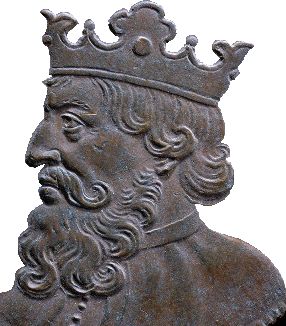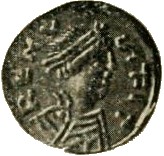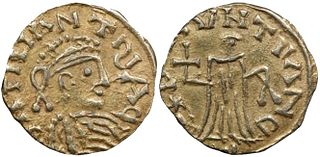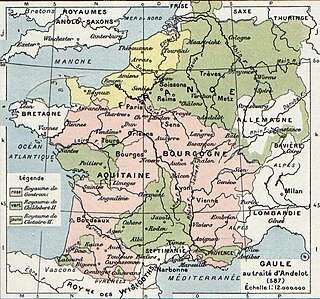The 580s decade ran from January 1, 580, to December 31, 589.

Year 587 (DLXXXVII) was a common year starting on Wednesday of the Julian calendar. The denomination 587 for this year has been used since the early medieval period, when the Anno Domini calendar era became the prevalent method in Europe for naming years.

Gregory of Tours was a Gallo-Roman historian and Bishop of Tours during the Merovingian period and is known as the "father of French history." He was a prelate in the Merovingian kingdom, encompassing Gaul's historic region.

Austrasia was a territory which formed the north-eastern section of the Kingdom of the Franks from the 6th to 8th centuries, ruled by the Frankish Merovingian and Carolingian dynasties during the Early Middle Ages. It was centred on the Meuse, Middle Rhine, and the Moselle rivers, and was the original territory of the Franks, including both the so-called Salians and Rhineland Franks, which Clovis I, King of the Franks (481–511) conquered after first taking control of the bordering part of Roman Gaul, which is sometimes described in this period as Neustria.

Chlothar II, sometime called "the Young", was king of Neustria and king of the Franks, and the son of Chilperic I and his third wife, Fredegund. He started his reign as an infant under the regency of his mother, who was in an uneasy alliance with Chlothar's uncle King Guntram of Burgundy, who died in 592. Chlothar took power upon the death of his mother in 597; though rich, Neustria was one of the smallest portions of Francia. He continued his mother's feud with Queen Brunhilda with equal viciousness and bloodshed, finally achieving her execution in an especially brutal manner in 613, after winning the battle that enabled Chlothar to unite Francia under his rule. Like his father, he built up his territories by seizing lands after the deaths of other kings.

Chilperic I was the king of Neustria from 561 to his death. He was one of the sons of the Frankish king Clotaire I and Queen Aregund.

Childebert II (c.570–596) was the Merovingian king of Austrasia from 575 until his death in March 596, as the only son of Sigebert I and Brunhilda of Austrasia; and the king of Burgundy from 592 to his death, as the adopted son of his uncle Guntram.

Francia, also called the Kingdom of the Franks, Frankish Kingdom, Frankland or Frankish Empire, was the largest post-Roman barbarian kingdom in Western Europe. It was ruled by the Frankish Merovingian and Carolingian dynasties during the Early Middle Ages. Francia was among the last surviving Germanic kingdoms from the Migration Period era.

Sigebert I was a Frankish king of Austrasia from the death of his father in 561 to his own death. He was the third surviving son out of four of Clotaire I and Ingund. His reign found him mostly occupied with a successful civil war against his half-brother, Chilperic.
Fredegund or Fredegunda was the Queen consort of Chilperic I, the Merovingian Frankish king of Soissons. Fredegund served as regent during the minority of her son Chlothar II from 584 until 597.

Charibert I was the Merovingian King of Paris, the second-eldest son of Chlothar I and his first wife Ingund. His elder brother Gunthar died sometime before their father's death. He shared in the partition of the Frankish kingdom that followed his father's death in 561, receiving the old kingdom of Childebert I, with its capital at Paris.

Saint Gontrand, also called Gontran, Gontram, Guntram, Gunthram, Gunthchramn, and Guntramnus, was the king of the Kingdom of Orléans from AD 561 to AD 592. He was the third-eldest and second-eldest-surviving son of Chlothar I and Ingunda. On his father's death in 561, he became king of a fourth of the Kingdom of the Franks, and made his capital at Orléans. The name "Gontrand" denotes "War Raven".
Brunhilda was queen consort of Austrasia, part of Francia, by marriage to the Merovingian king Sigebert I of Austrasia, and regent for her son, grandson and great-grandson.

Theuderic II (587–613), king of Burgundy (595–613) and Austrasia (612–613), was the second son of Childebert II. At his father's death in 595, he received Guntram's kingdom of Burgundy, with its capital at Orléans, while his elder brother, Theudebert II, received their father's kingdom of Austrasia, with its capital at Metz. He also received the lordship of the cities (civitates) of Toulouse, Agen, Nantes, Angers, Saintes, Angoulême, Périgueux, Blois, Chartres, and Le Mans. During his minority, and later, he reigned under the guidance of his grandmother Brunhilda, evicted from Austrasia by his brother Theudebert II.
Liber Historiae Francorum is a chronicle written anonymously during the 8th century. The first sections served as a secondary source for early Franks in the time of Marcomer, giving a short breviarum of events until the time of the late Merovingians. The subsequent sections of the chronicle are important primary sources for the contemporaneous history. They provide an account of the Pippinid family in Austrasia before they became the most famous Carolingians.
Basina, was a Frankish princess, the daughter and youngest child of Chilperic I, King of Soissons, and his first wife, Audovera. After surviving the assassination of her immediate family, she became a nun. She later helped to lead a rebellion by a group of the nuns, which became a scandal throughout the region. This event was chronicled by the bishop and saint, Gregory of Tours, who was one of the bishops chosen to settle the matter.

Andelot-Blancheville is a commune in the Haute-Marne department in the Grand Est region in northeastern France. It lies on the river Rognon, a tributary of the Marne.
Desiderius was a Gallo-Roman dux in the Kingdom of the Franks during the reigns of Chilperic I and Guntram. He served Chilperic as Duke of Aquitaine and was his greatest general.
Dynamius or Dinamius was the Rector of Provence from 575, when he replaced Albinus. At the time, Provence and Austrasia lay within the kingdom of Childebert II, though half of Marseille, the chief Provençal city, was under the lordship of Guntram, King of Burgundy.
Chlodosinda was a Frankish princess, the daughter of King Sigebert I and Queen Brunhilda.













